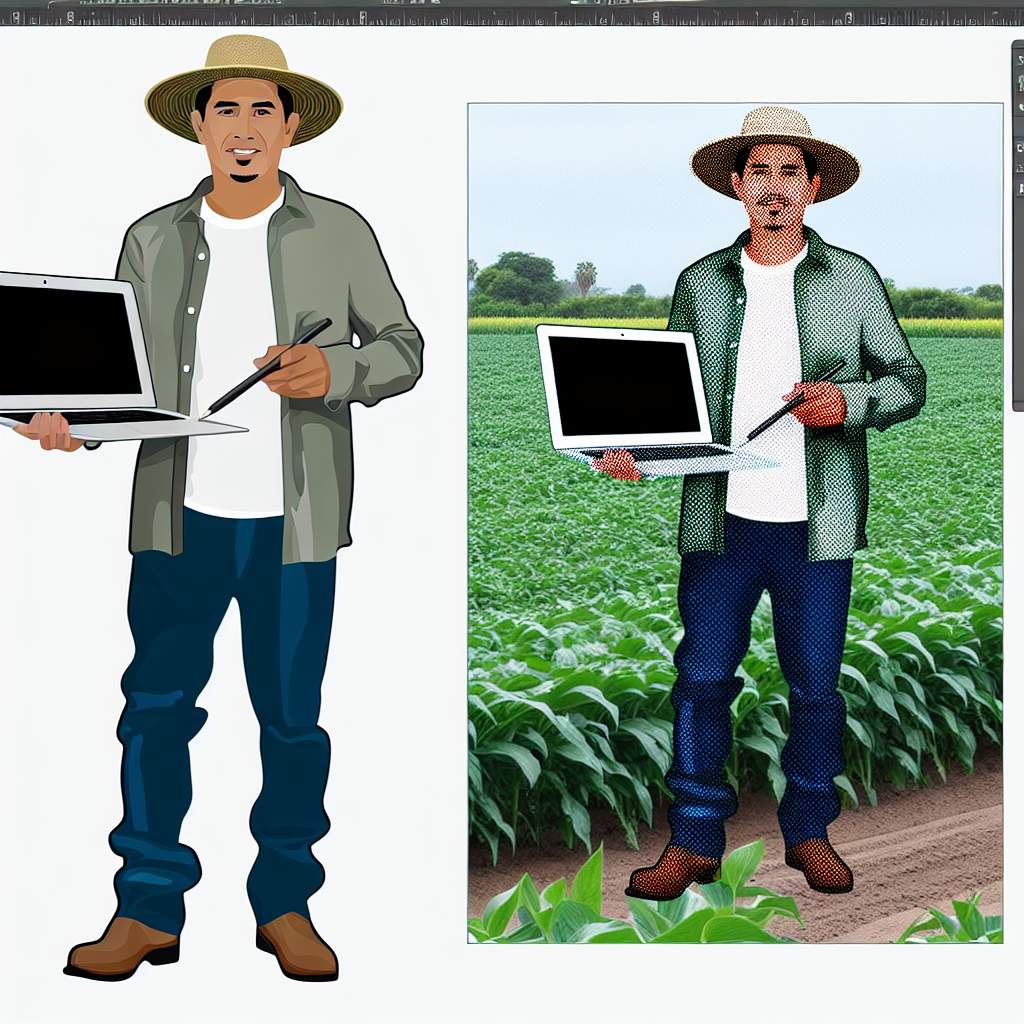Introduction to Precision Agriculture
Precision agriculture refers to farming practices that optimize returns on inputs while preserving resources.
This approach significantly enhances crop management and sustainability.
It uses technology to monitor and manage variations in the field.
Farmers apply specific techniques to improve efficiency and productivity.
Ultimately, precision agriculture aims for sustainable crop production.
Definition of Precision Agriculture
Precision agriculture is a data-driven farming management system.
It relies on technology to ensure the right practices are applied at the right time.
This technique improves decision-making about crop production.
Farmers use various tools, such as sensors, GPS, and drones.
Each tool provides valuable data for effective crop management.
Benefits and Impact of Precision Agriculture
The importance of precision agriculture lies in its ability to reduce waste.
Every input, including water and fertilizers, can be managed efficiently.
This technique boosts crop yields while minimizing environmental impact.
Furthermore, it helps farmers adapt to changing climate conditions.
As a result, precision agriculture contributes to food security globally.
Transform Your Agribusiness
Unlock your farm's potential with expert advice tailored to your needs. Get actionable steps that drive real results.
Get StartedKey Technologies in Precision Agriculture
Sensors
Sensors play a crucial role in precision agriculture.
They collect real-time data on soil condition and crop health.
This information helps farmers make informed decisions.
Various types of sensors include moisture, nutrient, and temperature sensors.
Moisture sensors monitor soil hydration levels effectively.
Nutrient sensors assess soil nutrient availability for crops.
Meanwhile, temperature sensors track microclimates within fields.
Farmers can utilize this data to optimize irrigation practices.
Consequently, they reduce water waste while enhancing crop yield.
Drones
Drones have transformed modern agricultural practices.
These unmanned aerial vehicles provide aerial views of fields.
Farmers can easily monitor large areas for crop health issues.
Drones are equipped with multispectral cameras for advanced analytics.
This technology identifies stressed plants through color differentiations.
Additionally, drones facilitate variable rate applications of inputs.
Farmers can apply fertilizers and pesticides more efficiently.
Thus, they achieve better resource management and environmental sustainability.
Software
Software plays a pivotal role in data analysis.
Farm management software integrates data from various sources.
This includes sensor inputs, drone imagery, and historical data.
Some popular software platforms include AgLeader and Trimble.
These tools offer actionable insights for farming operations.
Farmers can track field conditions and make timely decisions.
Furthermore, predictive analytics helps in forecasting crop yields.
Showcase Your Farming Business
Publish your professional farming services profile on our blog for a one-time fee of $200 and reach a dedicated audience of farmers and agribusiness owners.
Publish Your ProfileThis software enhances decision-making processes.
Soil Health Monitoring
Importance of Soil Health
Soil health is crucial for sustainable agriculture.
Healthy soil promotes strong plant growth.
Furthermore, it enhances nutrient cycling and water retention.
Techniques for Soil Health Assessment
Various techniques help monitor soil health effectively.
Soil testing is a fundamental approach.
Regular soil tests reveal nutrient levels and pH balance.
In addition, assessing soil texture provides insights into its physical health.
Physical Assessments
Physical assessments often focus on soil structure.
Good soil structure supports root development.
Moreover, it prevents erosion and minimizes compaction.
Chemical Assessments
Chemical assessments analyze nutrient availability.
These tests indicate levels of nitrogen, phosphorus, and potassium.
Additionally, they help identify potential toxic elements in the soil.
Biological Assessments
Biological assessments evaluate microbial activity.
Microbial life indicates soil health and fertility.
Healthy soils typically host diverse microorganisms.
Tools for Soil Health Monitoring
Several tools assist in soil health monitoring.
Soil probes allow for easy sample collection.
Moreover, pH meters quickly assess soil acidity.
Utilizing digital platforms enhances data analysis and management.
Emerging Technologies
Remote sensing technologies offer innovative monitoring solutions.
Drones capture detailed images and assess land conditions.
Additionally, soil sensors provide real-time data on moisture levels.
Community Resources
Local extension services often offer valuable insights.
Farmers can access training programs to improve soil management.
Collaboration with agronomists helps tailor soil health strategies.
Find Out More: Sustainable Irrigation Practices for Preserving Aquatic Ecosystems
Variable Rate Technology (VRT): Optimizing Inputs for Sustainable Yield
Introduction to Variable Rate Technology
Variable Rate Technology significantly enhances crop management practices.
Farmers use VRT to apply inputs like seeds and fertilizers precisely.
This method ensures resources are not wasted.
Benefits of Variable Rate Technology
VRT improves crop yields by tailoring applications to specific field conditions.
As a result, farmers can achieve higher efficiency in resource use.
Moreover, this technique reduces environmental impact and fosters sustainability.
Enhanced Resource Management
Farmers can use detailed soil maps to guide their applications.
By directing inputs where needed, they minimize over-application risks.
This targeted approach aids in maintaining soil health.
Cost Efficiency
Implementing VRT can reduce input costs significantly.
Less waste leads directly to lower expenses for farmers.
This cost-saving effect allows for investment in additional sustainable practices.
Showcase Your Farming Business
Publish your professional farming services profile on our blog for a one-time fee of $200 and reach a dedicated audience of farmers and agribusiness owners.
Publish Your ProfileHow VRT Works
VRT utilizes GPS technology to achieve precise applications.
Data on soil type and fertility variations guides the process.
Farmers gather this information through sensors and aerial imagery.
Data Collection Methods
Farmers can employ soil sampling to assess nutrient levels.
Remote sensing technologies provide valuable insights into crop health.
These data collection methods are crucial for effective VRT implementation.
Application Equipment
Modern agricultural equipment supports VRT applications efficiently.
Specialized tools can regulate input delivery based on data gathered.
Thus, farmers can easily adjust their application rates in real time.
Challenges and Considerations
While VRT offers numerous benefits, implementation can pose challenges.
Initially, the costs for technology and training can be high.
Additionally, farmers need access to reliable data sources.
Addressing Technology Costs
Farmers might consider collaborating with nearby growers to share resources.
This approach can offset individual costs of technology acquisition.
Sharing expertise can also enhance the implementation process.
Data Management and Availability
Utilizing accurate and up-to-date data is essential for VRT success.
Farmers should invest in good data management systems.
Access to agronomic expertise can help optimize data usage.
You Might Also Like: Sustainable Farm Certification for Sustainable Aquaponics and Hydroponics
Data Analytics in Agriculture: Making Informed Decisions
Introduction to Data Analytics
Data analytics transforms agricultural practices significantly.
Farmers can make better decisions using data insights.
This approach improves efficiency and sustainability.
Types of Data Used in Agriculture
Agriculture relies on various data types.
Soil data helps assess nutrient levels and pH balance.
Weather data provides insights into climate conditions.
Crop health data monitors plant growth and health.
Market data guides pricing and sale strategies.
Tools for Data Collection
Several tools assist in data collection within agriculture.
Remote sensing technologies enhance data accuracy.
Drones capture high-resolution images of fields.
Soil sensors measure moisture and nutrient levels.
Mobile apps streamline data gathering and analysis.
Benefits of Data Analytics
Data analytics offers multiple advantages for farmers.
It increases crop yields by optimizing input usage.
Farmers can detect pests and diseases early.
Moreover, it reduces waste through precise resource management.
Additionally, it enables better compliance with regulations.
Examples of Successful Data Analytics Implementation
Many farms successfully leverage data analytics.
For instance, Sunny Ridge Farms boosted yields by 15% using data.
They implemented sensors to monitor moisture levels accurately.
Showcase Your Farming Business
Publish your professional farming services profile on our blog for a one-time fee of $200 and reach a dedicated audience of farmers and agribusiness owners.
Publish Your ProfileAnother example is Green Valley Agro, which uses drones for crop inspection.
This strategy allows them to target areas needing attention promptly.
Emerging Trends in Agricultural Data Analytics
The future of agricultural data analytics looks promising.
Artificial intelligence will enhance data interpretation capabilities.
Farmers will increasingly adopt precision agriculture techniques.
Moreover, collaboration tools will emerge for shared insights.
Ultimately, these trends will support sustainable practices in agriculture.
See Related Content: Biogas Production and Its Role in Farm Sustainability
Integrating Precision Agriculture with Sustainable Practices
Understanding Precision Agriculture
Precision agriculture utilizes technology to optimize farming practices.
This method involves collecting data about soil and crop conditions.
It also helps farmers make informed decisions about resource usage.
Benefits of Sustainable Practices
Sustainable practices enhance environmental health and biodiversity.
They reduce dependency on chemical fertilizers and pesticides.
These practices promote soil health and water conservation.
Combining Techniques for Optimal Yield
Integrating precision agriculture with sustainable practices maximizes crop yields.
For example, using soil sensors allows targeted water application.
This method conserves water while promoting crop health.
Implementing Technology in the Field
Farmers can use GPS technology for efficient field mapping.
Drones provide aerial imagery to monitor crop health effectively.
These technologies facilitate real-time decision-making in farming.
Data-Driven Decision Making
Precision agriculture enables data analysis for improved outcomes.
Farmers can assess historical data to forecast future needs.
This approach ensures resources are allocated effectively.
Challenges in Integration
Implementing precision agriculture may require significant investment.
There is a learning curve for farmers unfamiliar with technology.
Support and training are essential to overcome these barriers.
Emerging Developments in Sustainable Agriculture
The future of agriculture lies in smart technology and sustainability.
Innovations in biotechnology will further enhance crop resilience.
Climate-smart practices will become increasingly important.
Find Out More: Growing Medicinal Plants in Agroforestry Systems Across the USA

Case Studies: Successful Implementation of Precision Agriculture Techniques
Overview of Case Studies
This section explores successful case studies in precision agriculture.
Various farms illustrate effective techniques and positive outcomes.
Each example highlights a different approach to sustainable crop management.
Case Study: Green Valley Farms
Green Valley Farms utilizes drones for crop monitoring.
These drones collect data on crop health and soil moisture.
The farm analyzes this information to optimize irrigation schedules.
As a result, water usage has decreased by 30%.
This technique also improved overall crop yield by 15%.
- Drones capture high-resolution images of the fields.
- Data analytics software processes the collected data.
- Targeted irrigation reduces waste and improves plant health.
Case Study: Eco Farms
Eco Farms employs precision planting technology.
This method ensures seeds are planted at optimal depths.
Showcase Your Farming Business
Publish your professional farming services profile on our blog for a one-time fee of $200 and reach a dedicated audience of farmers and agribusiness owners.
Publish Your ProfileAs a consequence, plants achieve better nutrient uptake.
Furthermore, Eco Farms reduces seed costs by 20%.
- Variable rate planting adjusts seed distribution automatically.
- Precision sensors provide real-time soil feedback.
- Data-driven decisions enhance overall farm efficiency.
Case Study: Harvest Innovations
Harvest Innovations integrates soil sensors into their management practices.
These sensors measure moisture, nutrient levels, and pH balances.
By analyzing this data, they implement targeted fertilization strategies.
This practice has led to a significant reduction in chemical inputs.
- Fertilizer costs have decreased by 25%.
- Crop quality and taste have improved notably.
- Sustainable practices contribute to environmental protection.
Insights from Case Studies on Precision Agriculture
These case studies demonstrate the efficacy of precision agriculture techniques.
Each farm showcases innovative approaches to sustainable practices.
Moreover, these methods lead to increased productivity and resource conservation.
As a result, precision agriculture offers viable solutions for modern farming challenges.




